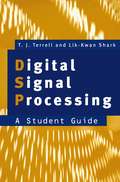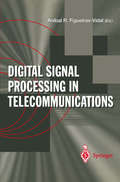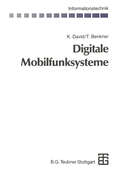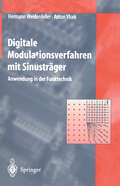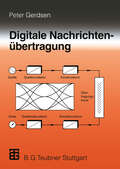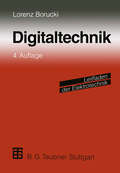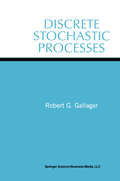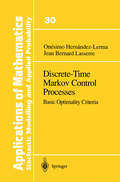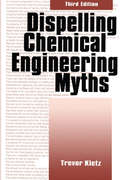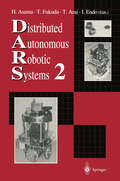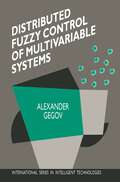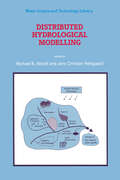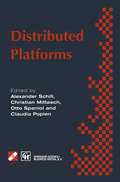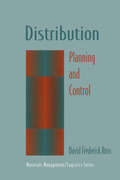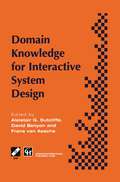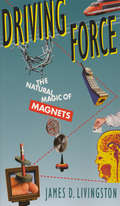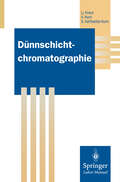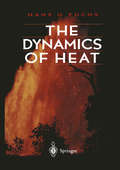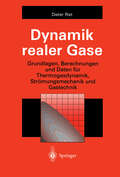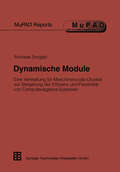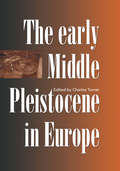- Table View
- List View
Digital Signal Processing: A Student's Guide
by Lik-Kwan Shark T.J. TerrellDigital signal processing (DSP) systems have developed at a rapid pace over the past two decades, and in recent years they have made a considerable impact in many areas of signal processing applications. DSP techniques play a significant role in the development and effective operation of networked super information highways, and undoubtedly DSP systems will be increasingly applied in response to the ever-growing market demand to provide and rapidly process more and more signal-data transmitted over various forms of communication channel. To promote and sustain such advances, there is a continuing requirement for engineers, scientists and technologists to have a good working knowledge of DSP concepts, design methods and practical implementation considerations. DSP therefore forms a significant part of the core material in many technician, undergraduate and postgraduate courses, especially those offered in electronic and engineering and computing disciplines. This book provides a basic student's guide to DSP and associated practical applications. Throughout, theoretical and practical concepts of DSP are presented in an introductory summary format, underpinned and demonstrated by more than 70 worked examples and a number of case studies. There are also problems at the end of each chapter; solutions to these are provided at the back of the book.
Digital Signal Processing in Telecommunications: European Project COST#229 Technical Contributions
by Anibal R. Figueiras-VidalThis publication deals with the application of advanced digital signal processing techniques and neural networks to various telecommunication problems. The editor presents the latest research results in areas such as arrays, mobile channels, acoustic echo cancellation, speech coding and adaptive filtering in varying environments.
Digitale Modulationsverfahren mit Sinusträger: Anwendung in der Funktechnik
by Hermann Weidenfeller Anton VlcekDieses sehr oft abstrakte Gebiet der Nachrichtentechnik wird vom Autor auf dem Niveau des Industriepraktikers behandelt. Daher finden Hardwareaspekte stärker Berücksichtigung als in einem theoretischen Buch.
Digitale Nachrichtenübertragung: Grundlagen, Systeme, Technik, praktische Anwendungen
by Peter GerdsenDiscrete Stochastic Processes (The Springer International Series in Engineering and Computer Science #321)
by Robert G. GallagerStochastic processes are found in probabilistic systems that evolve with time. Discrete stochastic processes change by only integer time steps (for some time scale), or are characterized by discrete occurrences at arbitrary times. Discrete Stochastic Processes helps the reader develop the understanding and intuition necessary to apply stochastic process theory in engineering, science and operations research. The book approaches the subject via many simple examples which build insight into the structure of stochastic processes and the general effect of these phenomena in real systems. The book presents mathematical ideas without recourse to measure theory, using only minimal mathematical analysis. In the proofs and explanations, clarity is favored over formal rigor, and simplicity over generality. Numerous examples are given to show how results fail to hold when all the conditions are not satisfied. Audience: An excellent textbook for a graduate level course in engineering and operations research. Also an invaluable reference for all those requiring a deeper understanding of the subject.
Discrete-Time Markov Control Processes: Basic Optimality Criteria (Stochastic Modelling and Applied Probability #30)
by Onesimo Hernandez-Lerma Jean B. LasserreThis book presents the first part of a planned two-volume series devoted to a systematic exposition of some recent developments in the theory of discrete-time Markov control processes (MCPs). Interest is mainly confined to MCPs with Borel state and control (or action) spaces, and possibly unbounded costs and noncompact control constraint sets. MCPs are a class of stochastic control problems, also known as Markov decision processes, controlled Markov processes, or stochastic dynamic pro grams; sometimes, particularly when the state space is a countable set, they are also called Markov decision (or controlled Markov) chains. Regardless of the name used, MCPs appear in many fields, for example, engineering, economics, operations research, statistics, renewable and nonrenewable re source management, (control of) epidemics, etc. However, most of the lit erature (say, at least 90%) is concentrated on MCPs for which (a) the state space is a countable set, and/or (b) the costs-per-stage are bounded, and/or (c) the control constraint sets are compact. But curiously enough, the most widely used control model in engineering and economics--namely the LQ (Linear system/Quadratic cost) model-satisfies none of these conditions. Moreover, when dealing with "partially observable" systems) a standard approach is to transform them into equivalent "completely observable" sys tems in a larger state space (in fact, a space of probability measures), which is uncountable even if the original state process is finite-valued.
Dispelling chemical industry myths
by Trevor A. KletzThis book covers myths about technology, management, toxicology, and the environment. It helps all who work in the chemical industry and all chemical engineers, including teachers and students to avoid accidents and wrong decisions and use resources more effectively.
Dispelling chemical industry myths (Chemical Engineering Ser.)
by Trevor A. KletzThis book covers myths about technology, management, toxicology, and the environment. It helps all who work in the chemical industry and all chemical engineers, including teachers and students to avoid accidents and wrong decisions and use resources more effectively.
Distributed Autonomous Robotic Systems 2
by Hajime Asama Toshio Fukuda Tamio Arai Isao EndoGreat interest is now focused on distributed autonomous robotic systems (DARS) as a new strategy for the realization of flexible, robust, and intelligent robots. Inspired by autonomous, decentralized, and self-organizing biological systems, the field of DARS encompasses broad interdisciplinary technologies related not only to robotics and computer engineering but also to biology and psychology. The rapidly growing interest in this new area of research was manifest in the first volume of Distributed Autonomous Robotic Systems, published in 1994. This second volume in the series presents the most recent work by eminent researchers and includes such topics as multirobot control, distributed robotic systems design, self-organizing systems, and sensing and navigation for cooperative robots. Distributed Autonomous Robotic Systems 2 is a valuable source for those whose work involves robotics and will be of great interest to those in the fields of artificial intelligence, self-organizing systems, artificial life, and computer science.
Distributed Fuzzy Control of Multivariable Systems (International Series in Intelligent Technologies #6)
by Alexander GegovIt is known that many control processes are characterized by both quantitative and qualitative complexity. Tbe quantitative complexity is usually expressed in a large number of state variables, respectively high dimensional mathematical model. Tbe qualitative complexity is usually associated with uncertain behaviour, respectively approximately known mathematical model. If the above two aspects of complexity are considered separately, the corresponding control problem can be easily solved. On one hand, large scale systems theory has existed for more than 20 years and has proved its capabilities in solving high dimensional control problems on the basis of decomposition, hierarchy, decentralization and multilayers. On the other hand, the fuzzy linguistic approach is almost at the same age and has shown its advantages in solving approximately formulated control problems on the basis of linguistic reasoning and logical inference. However, if both aspects of complexity are considered together, the corresponding control problem becomes non-trivial and does not have an easy solution. Modem control theory and practice have reacted accordingly to the above mentioned new cballenges of tbe day by utilizing the latest achievements in computer technology and artificial intelligence distributed computation and intelligent operation. In this respect, a new field has emerged in the last decade, called " Distributed intelligent control systems" . However, the majority of the familiar works in this field are still either on an empirical or on a conceptual level and this is a significant drawback.
Distributed Hydrological Modelling (Water Science and Technology Library #22)
by Michael B. Abbott Jens Christian RefsgaardIt is the task of the engineer, as of any other professional person, to do everything that is reasonably possible to analyse the difficulties with which his or her client is confronted, and on this basis to design solutions and implement these in practice. The distributed hydrological model is, correspondingly, the means for doing everything that is reasonably possible - of mobilising as much data and testing it with as much knowledge as is economically feasible - for the purpose of analysing problems and of designing and implementing remedial measures in the case of difficulties arising within the hydrological cycle. Thus the aim of distributed hydrologic modelling is to make the fullest use of cartographic data, of geological data, of satellite data, of stream discharge measurements, of borehole data, of observations of crops and other vegetation, of historical records of floods and droughts, and indeed of everything else that has ever been recorded or remembered, and then to apply to this everything that is known about meteorology, plant physiology, soil physics, hydrogeology, sediment transport and everything else that is relevant within this context. Of course, no matter how much data we have and no matter how much we know, it will never be enough to treat some problems and some situations, but still we can aim in this way to do the best that we possibly can.
Distributed Platforms: Proceedings of the IFIP/IEEE International Conference on Distributed Platforms: Client/Server and Beyond: DCE, CORBA, ODP and Advanced Distributed Applications (IFIP Advances in Information and Communication Technology)
by Alexander SchillClient/Server applications are of increasing importance in industry, and have been improved by advanced distributed object-oriented techniques, dedicated tool support and both multimedia and mobile computing extensions. Recent responses to this trend are standardized distributed platforms and models including the Distributed Computing Environment (DCE) of the Open Software Foundation (OS F), Open Distributed Processing (ODP), and the Common Object Request Broker Architecture (CORBA) of the Object Management Group (OMG). These proceedings are the compilation of papers from the technical stream of the IFIPIIEEE International Conference on Distributed Platforms, Dresden, Germany. This conference has been sponsored by IFIP TC6.1, by the IEEE Communications Society, and by the German Association of Computer Science (GI -Gesellschaft fur Informatik). ICDP'96 was organized jointly by Dresden University of Technology and Aachen University of Technology. It is closely related to the International Workshop on OSF DCE in Karlsruhe, 1993, and to the IFIP International Conference on Open Distributed Processing. ICDP has been designed to bring together researchers and practitioners who are studying and developing new methodologies, tools and technologies for advanced client/server environ ments, distributed systems, and network applications based on distributed platforms.
Distribution: Planning and Control
by David F. RossIt has been said that every generation of historians seeks to rewrite what a previous generation had established as the standard interpretations of the motives and circumstances shaping the fabric of historical events. It is not that the facts of history have changed. No one will dispute that the battle of Waterloo occurred on June 11, 1815 or that the allied invasion of Europe began on June 6, 1944. What each new age of historians are attempting to do is to reinterpret the motives of men and the force of circumstance impacting the direction of past events based on the factual, social, intellectual, and cultural milieu of their own generation. By examining the facts of history from a new perspective, today's historians hope to reveal some new truth that will not only illuminate the course of history but also validate contempo rary values and societal ideals. Although it is true that tackling the task of developing a new text on logistics and distribution channel management focuses less on schools of philosophical and social analysis and more on the calculus of managing sales campaigns, inventory replenishment, and income statements, the goal of the management scientist, like the historian, is to merge the facts and figures of the discipline with today's organizational, cultural, and economic realities. Hopefully, the result will be a new synthesis, where a whole new perspective will break forth, exposing new directions and opportunities.
Domain Knowledge for Interactive System Design (IFIP Advances in Information and Communication Technology)
by Alistair G. Sutcliffe Frans Van Assche David BenyonThis book describes how domain knowledge can be used in the design of interactive systems. It includes discussion of the theories and models of domain, generic domain architectures and construction of system components for specific domains. It draws on research experience from the Information Systems, Software Engineering and Human Computer Interaction communities.
Driving Force: The Natural Magic of Magnets
by James D. LivingstonDriving Force unfolds the long and colorful history of magnets: how they guided (or misguided) Columbus; mesmerized eighteenth-century Paris but failed to fool Benjamin Franklin; lifted AC power over its rival, DC, despite all the animals, one human among them, executed along the way; led Einstein to the theory of relativity; helped defeat Hitler’s U-boats; inspired writers from Plato to Dave Barry. In a way that will delight and instruct even the nonmathematical among us, James Livingston shows us how scientists today are creating magnets and superconductors that can levitate high-speed trains, produce images of our internal organs, steer high-energy particles in giant accelerators, and—last but not least—heat our morning coffee. From the “new” science of materials to everyday technology, Driving Force makes the workings of magnets a matter of practical wonder. The book will inform and entertain technical and nontechnical readers alike and will give them a clearer sense of the force behind so much of the working world.
Dünnschichtchromatographie (Springer Labormanuale)
by Ljubomir Kraus Angelika Koch Sabrina Hoffstetter-KuhnDieser praxisbezogene Leitfaden geht speziell auf die von L. Kraus entwickelte Horizontalkammer ein, eine zugelassene Methode, die von der WHO zur Kontrolle von Arzneipflanzen anerkannt ist. Die DC-Technik, stationäre und mobile Phasen und Nachweismethoden werden ausführlich beschrieben und durch zahlreiche Anwendungsbeispiele und exzellente Farbabbildungen der wichtigsten Chromatogramme ergänzt.
The Dynamics of Heat
by Hans U. FuchsBased on a course given to beginning physics, chemistry, and engineering students at the Winterthur Polytechnic Institute, this text approaches the fundamentals of thermodynamics from the viewpoint of continuum mechanics. By describing physical processes in terms of the flow and balance of physical quantities, the book provides a unified approach to hydraulics, electricity, mechanics and thermodynamics. In this way it becomes clear that the entropy is the fundamental property that is transported in thermal processes and that the temperature is its measure.Previous knowledge of thermodynamics is not required, but readers should be familiar with basic electricity, mechanics, and chemistry and should have some knowledge of elementary calculus. Both the theory and applications are included as well as many exercises and solved problems from various fields of science and engineering.
Dynamik realer Gase: Grundlagen, Berechnungen und Daten für Thermogasdynamik, Strömungsmechanik und Gastechnik
by Dieter RistDieses Werk über die Dynamik und Thermodynamik industrieller Gase ist wegen seiner Vollständigkeit und Genauigkeit eine einzigartige Informationsquelle für Ingenieure in der Gasindustrie, der Triebwerks- und Turbinentechnik, dem Rohrleitungs -und Behälterbau, der chemischen Industrie und verwandter Felder.
Dynamische Module: Eine Verwaltung für Maschinencode-Objekte zur Steigerung der Effizienz und Flexibilität von Computeralgebra-Systemen (MuPad Reports)
by Andreas SorgatzThe Early Middle Pleistocene in Europe
by Charles TurnerThese papers show how new research in the classic areas and Germany, but particularly in Eastern Europe, is radically altering views of the stratigraphy and palaeocology of the early-middle Pleistocene period, showing that major glaciations did not begin only in the late- middle Pleistocene.
The Early Middle Pleistocene in Europe
by Charles TurnerThese papers show how new research in the classic areas and Germany, but particularly in Eastern Europe, is radically altering views of the stratigraphy and palaeocology of the early-middle Pleistocene period, showing that major glaciations did not begin only in the late- middle Pleistocene.
